#notion operations dashboard
Explore tagged Tumblr posts
Text
Newsletter Operating System (Notion Dashboard)

Introducing the Newsletter Operating System (Notion Dashboard)—a comprehensive tool meticulously designed to streamline and enhance your newsletter creation journey. Whether you're an independent writer or planning to launch your own newsletter, this Notion-based dashboard offers an all-in-one solution to curate, write, and grow your publication effectively. Buy now - click here
#notion#notion app#notion productivity#notion database#notion productivity app#notion template#notion table#notion how to#notion pages#personal operating system#notion templates#notion pro#notion dashboard#notion project management#notion setup#operating system#notion knowledge management#notion knowledge hub#notion tutorial#small business systems#business operations system#systems#notion linked#notion operations dashboard
0 notes
Note
Hello Kiki I think its super nice that you are protecting this blog and your peace so here’s a suggestion! I think tracking notes is going to be harder because it’s very hard to know who is a fake account or how many times someone comments or reblogs so, I think it’s a good idea you let the tumblr goal as it is, but make it so the wattpad goal has to be reached as well. That way you don’t go crazy with the tumblr notes and discerning who is who, and we also can boost your stories on wattpad to get you more engagement !!! 🩷🩷🩷 :D
Okay wait, this is actually such a good point—noted and filed away in my mental Notion dashboard!!! You’re totally right that tracking fake accounts manually is a mess and a half (my brain is not ready to be a one-woman CIA operation), and tying the goal to Wattpad engagement too could help keep things balanced without sending me into burnout detective mode.
So yes—keeping the Tumblr note goal as it is plus requiring the Wattpad goal to be hit too? That feels like a really solid compromise. It supports visibility across both platforms and gives me a clearer picture of who’s actually present.
Thank you for the thoughtful suggestion and the kindness in how you phrased it. I really appreciate that. <3
Adding this to the potential system tweaks list as we speak.
4 notes
·
View notes
Text
Smart Mobility for All- Yasyas Brings Electric Bikes Within Everyone’s Reach
In an era where cities are becoming more crowded, pollution levels are rising, and public transport is often unreliable, electric mobility offers a practical, clean, and efficient solution. But despite their many benefits, electric bikes have often been viewed as a luxury that only a few could afford. Yasyas challenges this notion by making smart mobility not only accessible but inclusive. With their range of affordable, high-quality electric bikes, Yasyas is on a mission to put clean, efficient transportation within everyone’s reach.
Yasyas Electric Bikes are designed with the everyday commuter in mind—whether it’s a student traveling to college, a working professional avoiding traffic jams, or a delivery rider looking for a cost-effective and reliable vehicle. These bikes combine technology, sustainability, and affordability in a way that meets the diverse needs of India’s growing urban population.
At the core of Yasyas’ philosophy is inclusivity. Their pricing strategy ensures that electric bikes are no longer a premium product but a daily utility available to all. With options across various price segments, Yasyas makes it easy for people from different economic backgrounds to join the e-mobility revolution. Whether you're buying your first vehicle or upgrading from a conventional two-wheeler, there’s a Yasyas eBike for you.
Another factor that makes Yasyas stand out is their focus on real-world usability. These electric bikes are not just stylish or trendy—they are built for Indian roads and everyday use. From robust frames and shock-absorbing suspensions to reliable braking systems and long-lasting batteries, every Yasyas bike is engineered to perform under a range of urban conditions. The result is a ride that’s smooth, safe, and dependable, day after day.
Furthermore, Yasyas integrates smart features that simplify life for users. Digital dashboards, USB charging ports, LED lighting, and even app-based vehicle diagnostics in select models ensure that riders stay connected and informed. These features make Yasyas eBikes not just an alternative to fuel-powered vehicles, but a smarter and more enjoyable upgrade.
Yasyas also offers excellent after-sales support and service coverage, making maintenance stress-free. With lower operating costs compared to petrol vehicles and minimal maintenance requirements, owning a Yasyas bike makes long-term financial sense. It’s not just an environmentally friendly decision—it’s an economically wise one too.
Conclusion: Yasyas is redefining urban transportation by making electric bikes an affordable and smart mobility choice for everyone. Their commitment to sustainability, practicality, and inclusivity makes them a standout in India’s rapidly evolving electric vehicle market. If you're ready to experience the future of commuting, yasyas.com is your starting point. Explore their models and join a movement that’s not just about riding electric—it’s about empowering every rider to move smarter, cleaner, and more affordably.
0 notes
Text
How to Automate Workflows with Webhooks and APIs
Manual processes waste time, create bottlenecks, and increase the risk of errors. That’s why modern businesses are turning to automation to streamline their operations—and two of the most powerful tools enabling this transformation are webhooks and APIs.
A trusted Web Development Company can help you integrate both seamlessly into your digital ecosystem, making your workflows faster, smarter, and more reliable. But how exactly do webhooks and APIs work, and how are they different? Let’s break it down.
What Are APIs?
APIs, or Application Programming Interfaces, are structured methods that allow two applications to communicate. Think of them as waiters in a restaurant—they take your request (e.g., “Get new leads from the CRM”), deliver it to the kitchen (the server), and bring back exactly what you ordered.
With APIs, your website or system can:
Pull data from third-party services (e.g., weather APIs, shipping APIs, payment gateways)
Send data to apps like Slack, HubSpot, or Google Sheets
Trigger specific actions within other platforms (e.g., creating a ticket in a helpdesk)
APIs are request-driven—they perform actions when you call or trigger them intentionally, usually on a schedule or based on events.
What Are Webhooks?
Webhooks are like real-time notifications sent automatically from one app to another when something specific happens. Instead of checking for updates repeatedly, webhooks push the update as soon as it occurs.
For example:
When someone submits a form on your website, a webhook sends that data instantly to your CRM.
When a payment is completed on Razorpay, a webhook updates the order status in your internal dashboard.
Unlike APIs, which pull data, webhooks push data the moment an event occurs.
How They Work Together
Webhooks and APIs often work hand-in-hand. Here’s a simple workflow example:
A customer makes a purchase on your eCommerce store.
The payment gateway sends a webhook to your server confirming the transaction.
Your server then uses an API to update the customer database and generate an invoice.
In short, webhooks trigger, and APIs act. Together, they form the backbone of modern workflow automation.
Popular Use Cases for Workflow Automation
A professional web development team can help automate dozens of processes using webhooks and APIs. Some common examples include:
CRM Syncing: Send leads from your website form to Salesforce or HubSpot instantly.
Email Notifications: Trigger transactional emails using SendGrid or Mailchimp when a user registers or purchases.
Slack Alerts: Post messages to a Slack channel when new support tickets are created.
Inventory Management: Auto-update stock counts across multiple sales channels like Amazon, Shopify, and WooCommerce.
Task Management: Auto-create tasks in Trello or Asana based on customer activity or support queries.
Payment Reconciliation: Receive real-time updates from Razorpay or Stripe and reflect them in your finance dashboard.
Tools and Platforms That Support Automation
Many tools today offer native support for both APIs and webhooks. Some examples include:
Zapier and Make (formerly Integromat) for no-code automation
Stripe, Razorpay, and PayPal for payment triggers
Shopify and WooCommerce for eCommerce workflows
Google Workspace APIs for document generation and sync
Airtable, Notion, and Slack for internal task automation
However, for custom workflows or enterprise-level requirements, working with a developer or agency ensures flexibility, scalability, and security.
Security & Monitoring
Since both webhooks and APIs handle sensitive data, security is critical. Top web development companies ensure:
Token-based authentication
Encrypted payloads
Retry mechanisms in case of delivery failures
Rate limiting to prevent abuse
Logging and monitoring to track workflow success or failure
With these in place, you can trust your automation to work reliably in the background while your team focuses on high-impact tasks.
Conclusion
Whether you're managing customer data, updating records, or streamlining operations across tools, APIs and webhooks offer a powerful foundation for automation. Partnering with a Web Development Company helps you design and deploy automation that’s secure, scalable, and perfectly tailored to your needs.
The result? Fewer manual tasks, fewer errors—and a digital infrastructure that runs like clockwork.
0 notes
Text
Why Every Team Needs an AI Copilot Solution in 2025?
The modern workplace has never moved faster. As we step into 2025, the speed of innovation, the complexity of workflows, and the expectations for productivity have all reached new heights. To stay competitive and agile, companies are turning to a new kind of team member: the AI Copilot.

Much more than a tool, an AI Copilot is a context-aware digital assistant that collaborates with human workers—offering insights, automating tasks, streamlining decisions, and enhancing creativity. Let’s explore why every team, across industries and functions, needs an AI Copilot solution in 2025.
1. Boosts Productivity Without Burnout
Workloads are growing, but humans have limits. AI Copilots help close the gap between increasing demand and human capacity. By summarizing long documents, generating reports, drafting emails, or even writing code, AI can drastically reduce time spent on routine tasks.
Instead of working longer hours, teams work smarter.
Stat to know: According to McKinsey, generative AI can automate up to 60–70% of employee time in functions like marketing, software development, customer service, and legal.
2. Enhances Decision-Making with Data-Driven Insights
In 2025, data is more abundant than ever—but raw data is only useful if interpreted correctly and quickly. AI Copilots can synthesize large datasets in real-time, generate visualizations, spot trends, and even suggest actions based on predictive analytics.
This helps teams make faster, smarter decisions without waiting on analysts or dashboards.
3. Bridges Skill Gaps and Democratizes Expertise
Not every team has a data scientist, a legal expert, or a senior marketer on hand. AI Copilots can act as knowledge bridges—providing answers, generating compliant documents, and helping less-experienced team members punch above their weight.
Whether it’s a junior developer using AI to write more efficient code or a sales rep generating a tailored pitch deck, AI evens the playing field.
4. Fosters Creativity and Innovation
AI is not just for automation; it’s a powerful collaborator for brainstorming and content creation. Marketing teams use AI to generate campaign ideas. Product teams simulate user flows with AI-driven prototypes. Even C-level executives use copilots to test strategies and scenario plan.
AI enables creativity at speed and scale—making teams not only more efficient, but also more innovative.
5. 24/7 Operational Agility
AI Copilots never sleep. They’re available across time zones and can handle queries and tasks asynchronously. In remote and hybrid teams, this is a game changer. AI ensures that no information is lost, no task forgotten, and no opportunity delayed—whether your teammate is in San Francisco or Singapore.
6. Improves Collaboration and Knowledge Sharing
AI Copilots can act as team memory—summarizing meetings, keeping track of action items, tagging documents, and making relevant past knowledge accessible when it's needed. This reduces duplication of effort and keeps everyone on the same page, literally and figuratively.
7. Adapts to Every Role and Industry
From HR to finance, from software to healthcare, AI Copilots are not one-size-fits-all. They're increasingly customizable and integrate deeply with existing workflows and tools (Slack, Notion, Jira, Salesforce, etc.).
The result? Every team—from frontline workers to leadership—can benefit without needing to reinvent the wheel.
The Future Is Not Human vs. AI—It’s Human + AI
Organizations that adopt AI Copilots in 2025 will outperform those that don’t—not by replacing human talent, but by amplifying it. The teams of tomorrow will be defined by how well they leverage AI to extend their capabilities.
AI Copilots aren’t a luxury anymore—they’re a strategic necessity.
Conclusion
As AI matures and becomes more accessible, the real question isn’t whether to use an AI Copilot Solution, but how fast you can onboard one. Businesses that embrace this shift early will see exponential gains in performance, engagement, and innovation.
0 notes
Text
From Freelancers to Full-Time: Scaling Your Remote Team the Smart Way

As companies more and more turn to flexible work models, most startups and scaling businesses are left with the same question: How do you scale from a handful of freelancers into a trustworthy, full-time remote team, without sacrificing quality, culture, or control? The good news? With the right systems and mindset for strategy, it's entirely possible to grow from a lean, nimble setup into a high-performing virtual department that compares to any in-office team. Here's how you can scale your remote team in a smart way. 1. Begin with Strategic Foundations Before you bring in your next employee, take a moment to reflect on where you are. Ask yourself:
What functions are being covered by freelancers currently?
Which tasks are recurrent and predictable?
Are there any roles that would be served best by full-time attention?
Start writing down these observations so you'll have an idea where the holes are and where to recruit first. Making the transition from ad hoc assistance to dedicated positions needs transparent planning—do not omit this process. 2. Make In-House Remote vs Dedicated Contractors Choice One-off work and tasks are excellent for freelancers. But when you expand, consistency, responsibility, and incorporation into a team grow in importance. This is where you transition to either:
Full-time remote employees (on payroll), or Dedicated long-term contractors (via platforms or agencies)
Not all jobs must be "employee status." Some can stay flexible yet retain a clear scope, KPIs, and team integration. The solution is structure—treat remote employees as part of the team, not temporary labor. 3. Leverage Time Zones as a Strength, not a Challenge One of the most intelligent things to do when scaling remote teams is to leverage global talent. When executed well, multiple time zones can be a strength. You can:
Have business coverage 24/7
Reduce project cycles with follow-the-sun workflows
Provide more international customer support
The secret is to write it all down, communicate asynchronously, and have transparency in overlap hours for collaboration. Tools such as Loom, Slack, Notion, and Trello can facilitate bridging the gaps. 4. Systematize Knowledge and Onboarding With an increasing team, tribal knowledge does not grow. You must have a playbook. Add
SOPs (Standard Operating Procedures)
Onboarding checklists
Company values and tone guidelines
Role-specific guides and FAQs
Invest in training early—it lessens reliance on founders and accelerates team productivity. Pro Tip: Create screen-share videos for processes so you save time and increase clarity for future hires. 5. Define Culture Early (Yes, Even for Remote Teams) Just because your team is remote does not mean you get to skip on building culture. It's actually more critical when you are scaling. Set the tone from the top:
What's your communication style?
Do you have flexible hours or rigid schedules?
How do you celebrate victories and provide feedback?
Employ rituals such as:
Weekly virtual standups
Monthly all-hands gatherings
Slack channels for fun and wellness
Annual or quarterly virtual team-building activities
Remember: Culture doesn't happen—it's created. 6. Track Output, Not Activity Micromanaging kills remote momentum. Rather than monitoring every move, create trust through clear expectations and metrics. Employ tools such as:
ClickUp or Asana for project timelines.
Time Doctor or Hubstaff if necessary for hourly tracking.
KPI dashboards for visibility into performance
Establish measurable goals and prioritize results, not time logged. Your team will thank you for your independence—and you'll see improved results. 7. Know When to Ask for Help Scaling comes with growing pains. You might not have bandwidth to handle hiring, onboarding, payroll, compliance, and people ops all at once. This is where collaboration with a remote hiring agency or PEO (Professional Employer Organization) can save time. They assist in:
Sourcing top talent around the world
Legislation and HR compliance
Dealing with benefits, taxes, and contracts
Onboarding and supporting remote workers seamlessly
Take these partners as growth accelerators—particularly when going global. 8. Promote from Within and Document Wins As your team expands, begin to identify potential team leads and future managers within your current organization. Freelancers who consistently generate value can become exceptional full-time contributors or mentors. Build case studies internally:
Document wins from every new hire
Highlight how the team's structure contributed to achieving milestones
Extract lessons learned for ongoing improvements
These narratives assist you in sharpening your remote hiring model and bringing in future team members more quickly. Final Thoughts Scaling from freelancers to a fully Hire Remote Team doesn't occur overnight, but with proper planning, tools, and attitude, it can be one of the most rewarding transitions for your business. Rather than shooting for fast, prioritize building right. A well-thought-out, strategically scaled remote team has the potential to be your competitive edge—agile, worldwide, and prepared for the future of work.
0 notes
Text
Automate Anything with Ease: A Beginner’s Guide to n8n Workflows

Imagine sipping your coffee while tasks run themselves—emails get sorted, data gets transferred between apps, and reminders are sent out—all without lifting a finger. Sounds dreamy, right? That’s exactly what automation tools like n8n can help you achieve. Whether you're a solo entrepreneur, freelancer, content creator, or just someone who wants to do more with less effort, learning n8n for Beginners: Build Automations from Scratch!! is your ticket to unlocking that superpower.
But what is n8n? Why should you even care about it? And most importantly—how can you use it without needing to be a coding wizard?
Let’s break it down, the simple way.
What is n8n?
n8n (pronounced “n-eight-n”) stands for “nodemation”—basically, node-based automation. It’s a free, open-source workflow automation tool that helps you connect different apps and services together. It’s kind of like Zapier or Integromat, but with more control and flexibility.
Here’s what makes n8n stand out:
✅ Open-source (so it’s customizable and free)
✅ Self-hosted or cloud (your choice)
✅ Powerful workflow builder
✅ Connects to 200+ apps (and growing)
✅ No-code/low-code platform
In other words, it gives you a visual playground where you can build automations—without needing to be a tech genius.
Why Automations Matter (Especially in 2025)
Time is your most valuable currency. In 2025, with the explosion of digital tools and platforms, we’re constantly switching between emails, CRMs, spreadsheets, Slack, Discord, social media—and the list goes on.
Manual work slows you down.
Automation helps you:
✅ Eliminate repetitive tasks
✅ Boost productivity
✅ Reduce human error
✅ Scale your business or operations faster
Now imagine setting up workflows in minutes that save you hours every week. That’s what n8n delivers.
Getting Started: Is n8n Really for Beginners?
Short answer? Absolutely.
Even if you're new to the world of automation, the n8n for Beginners: Build Automations from Scratch!! course guides you step-by-step in a super friendly, visual way.
You’ll learn:
✔️ How to install and access n8n
✔️ How to design your first workflow
✔️ Real-world automation examples (not boring theory)
✔️ How to connect tools like Gmail, Notion, Slack, Trello, etc.
✔️ How to automate your business processes like a pro
No need to be a developer. Just follow along, and you’ll be creating time-saving automations in no time.
Real-Life Examples: Where n8n Shines
Still wondering what kind of things you can automate? Let’s look at some real-life use cases:
📧 1. Automate Emails Based on Triggers
For example:
When someone fills out your contact form, send them a personalized email.
Notify your team on Slack or WhatsApp.
📋 2. Sync Your Spreadsheets
Say you update a Google Sheet with new leads—n8n can automatically add those leads to your CRM or Mailchimp list.
🔁 3. Social Media & Content Scheduling
Automate content posting across platforms like Twitter, Instagram, or LinkedIn. Trigger a post every time a blog goes live.
🔔 4. Reminders & Notifications
Create workflows to remind you about pending tasks, renewals, or client meetings.
📊 5. Reporting & Dashboards
Pull data from multiple platforms and generate auto-reports at the end of every week or month.
And that’s just the beginning.
How Does n8n Work?
Picture a flowchart. You start with a trigger (e.g., new email received), then add a node (e.g., filter emails with a certain subject), then another node (e.g., send a message to Slack), and so on.
Each step is a node in your workflow, and you can drag, drop, and configure them with a few clicks.
Here’s the typical workflow logic:
Trigger (an event like form submission)
Actions (do something based on the trigger)
Conditions (set filters or logic)
End Result (email, message, file, update, etc.)
And voilà—your automation is ready!
Why Choose n8n Over Other Tools?
There are many automation tools out there. But here’s why n8n is increasingly becoming the go-to platform: Featuren8nZapierMake (Integromat)Open Source✅ Yes❌ No❌ NoFree Tier LimitVery GenerousLimitedLimitedSelf-Hosting Option✅ Yes❌ No❌ NoCustom LogicHighly FlexibleLimitedModerateVisual Editor✅ Yes✅ Yes✅ Yes
n8n gives you the best of both worlds—no-code friendliness with advanced customization if you ever need it.
The Power of Self-Hosting (Optional but Awesome)
Want total control over your data and infrastructure? Self-hosting n8n is a game-changer. You can deploy it on your own server (VPS, Raspberry Pi, etc.) and have:
🔒 Full privacy
🔄 Infinite workflows
💰 Zero subscription costs
Don’t want to deal with servers? No worries. You can also use n8n.cloud, the official hosted version.
Top Benefits You’ll Gain from Learning n8n
Still on the fence? Here’s why learning n8n is 100% worth it:
🚀 Save time and money by replacing expensive tools
🎯 Sharpen your productivity skills
🧠 Become automation-savvy—a must-have skill in 2025
💼 Boost your resume if you’re in tech, marketing, or operations
🧰 Use it across any industry (marketing, SaaS, eCommerce, HR, etc.)
💡 Unlock ideas for your own projects or side hustles
Who Should Take This Course?
If you’re asking yourself, “Is this course for me?”—here’s who it’s perfect for:
Entrepreneurs looking to automate and scale
Freelancers and solopreneurs
Digital marketers
Virtual assistants
Developers who want low-code tools
Students or beginners in tech
Anyone tired of manual tasks!
If that sounds like you, then n8n for Beginners: Build Automations from Scratch!! is your perfect match.
Learn by Doing (Not Just Watching)
This course isn't just about watching tutorials—it’s hands-on. You’ll build real workflows step-by-step and walk away with automation superpowers you can use immediately.
And it’s beginner-friendly, so no prior experience is required.
Future-Proof Your Skills
Automation is not just a buzzword. It’s a business essential.
Companies are actively seeking people who can automate tasks, optimize processes, and manage workflows. Knowing how to use n8n gives you:
💼 A competitive edge in the job market
🔧 Practical skills to improve operations
💰 Opportunities to offer automation as a freelance service
You’re not just learning a tool—you’re future-proofing your career.
Final Thoughts: Start Automating Today
You don’t need to be a developer. You don’t need fancy software. All you need is the right guidance.
n8n is powerful, flexible, and accessible. With the right training, you’ll go from beginner to automation master in no time.
So why wait? Start building your first automation today with n8n for Beginners: Build Automations from Scratch!! and unlock a whole new level of productivity.
Let your workflows do the work—while you focus on what truly matters.
0 notes
Text
How to Manage a Business Remotely with a Virtual Office in Indore

Running a business no longer means being tied to a physical location. In today’s digital age, entrepreneurs, freelancers, and even full-fledged companies are increasingly turning to virtual offices to maintain flexibility while staying professional.
If you’ve chosen Indore—a fast-growing commercial hub in central India—you’re already on the right track. But how do you effectively manage a business remotely using a virtual office in Indore?
This blog walks you through practical strategies, tools, and tips to ensure your business operates smoothly—even when you’re not physically there.
1. Establish a Solid Communication System
The backbone of any remote business is communication. Just because you don’t have a traditional office doesn’t mean communication should suffer. Here’s how you can stay connected:
🔹 Use Team Collaboration Tools:
Slack for internal chats
Zoom or Google Meet for meetings
Asana or Trello for project tracking
🔹 For Clients:
Set up a dedicated business number
Use tools like Calendly for scheduling
Consider hiring a virtual receptionist via your virtual office provider
With a virtual office in Indore, you can also opt for call forwarding and mail handling services, ensuring you never miss important messages or documents.
2. Build a Documented Workflow
Remote work thrives on clarity. Document your processes so everyone knows what to do and how to do it—even in your absence. Create a central repository (Google Drive or Notion) for:
SOPs (Standard Operating Procedures)
Onboarding documents
Company policies and timelines
This helps eliminate confusion and ensures a consistent experience for both employees and clients.
3. Leverage Virtual Office Services
Most providers of virtual office in Indore offer more than just an address. Make sure you’re using the full range of features to support remote business operations:
Mail collection & forwarding: You’ll get notified when packages or legal notices arrive.
Meeting room access: Book them when you're in town or need face-to-face client discussions.
Document support: Many providers help with GST, ROC compliance, and courier services.
These offerings make it possible to run operations remotely without compromising professionalism.
4. Automate Your Business Processes
Automation saves time and reduces manual errors—especially when your team is remote. Use tools like:
Zapier: Automates workflows between apps
QuickBooks or Zoho Books: For accounting
HubSpot or Freshsales: For customer relationship management
Also consider automating responses for inquiries via chatbots or WhatsApp Business, so your business stays responsive 24/7.
5. Monitor Team Performance Without Micromanaging
Micromanaging is the quickest way to kill productivity and morale—especially remotely. Instead, build a system of accountability and autonomy.
How?
Weekly check-ins or scrums
Clear deadlines and deliverables
Performance dashboards (via tools like ClickUp or Basecamp)
Remote businesses thrive on trust and transparency, and your team will appreciate the freedom if expectations are clearly communicated.
6. Maintain a Local Business Presence
Even if you’re working from another city or country, clients and partners want to feel like your business is accessible. That’s where your virtual office in Indore plays a crucial role.
Use your Indore address for:
Invoices
Websites and social media
Client proposals
Legal documents
This gives your brand a local identity, especially if your target audience is in or around Madhya Pradesh.
7. Keep Compliance and Documentation Updated
Just because you're remote doesn’t mean you can neglect paperwork. Make sure you renew your:
Virtual office rent agreement
GST registration (if applicable)
ROC filings
Choose a provider that sends timely reminders and even assists with renewals or updates.
8. Plan Occasional On-Ground Activities
While remote is efficient, occasional physical interactions can strengthen business relationships. Use your virtual office to:
Host quarterly team meetups
Invite clients for presentations
Conduct interviews or partner discussions
Most Indore-based virtual offices offer flexible hourly or daily access to professional meeting spaces. Use these strategically to maintain a human touch.
9. Offer Flexible Work Models to Employees
One of the perks of remote business is attracting talent from across the country. Create a flexible model where employees:
Can work from home
Have the option to co-work at partner spaces in Indore (check if your virtual office offers this)
Attend monthly in-person strategy sessions
This makes your business adaptable and more appealing to modern professionals.
10. Stay Visible and Market Actively
Don’t let the “virtual” nature of your business make you invisible. Continue to market actively:
Use your Indore location in SEO and listings (e.g., “Consulting firm in Indore”)
Run social media campaigns highlighting your services
Join local directories and forums
Your virtual presence is only as strong as your digital visibility.
Final Thoughts
Running a business remotely is no longer a challenge—it’s an opportunity. And with a virtual office in Indore, you have everything you need to build a trusted, scalable, and professional business without sitting in a cubicle every day.
From local brand presence to legal compliance, mail handling to on-demand workspace access, the right virtual office setup helps you manage your operations smoothly while enjoying the flexibility of working from anywhere.
#VirtualOfficeIndore#RemoteWorkIndia#StartupIndore#WorkFromAnywhere#BusinessTips#FlexibleWorkspaces#EntrepreneurLife
0 notes
Text
How to Learn Driving Quickly Without Stress: A Beginner's Guide to Quick Car Mastery

Learning a way to pressure can be overwhelming, but it doesn’t need to be. With the proper approach, mindset, and training, you can turn out to be assured in back on the wheel in a quick time. Whether you're ultra-modern to riding or just want a self assurance increase, beginning with a reliable driving school Rotterdam will make all the difference. With expert teachers, patient guidance, and structured classes, you’ll avoid the stress and speed-track your adventure to studying the car.
1. Choose the Right Driving School
A trusted riding college units the tone for your mastering experience. Look for colleges with certified instructors, precise pupil reviews, flexible schedules, and a high pass rate. If you are in Rotterdam or the encompassing regions, you are looking for packages that emphasize calm, pupil-centered teaching and provide both automatic and guided training.
2. Start with the Basics
Before even stepping into a car, take time to understand the fundamentals. Learn about automobile controls, dashboard indicators, avenue signs and symptoms, and basic rules of the street. Familiarizing yourself with the concept facilitates lessening stress whilst you start realistic instructions.
3. Create a Consistent Schedule
Learning to drive speedily doesn’t imply cramming all of your lessons into one week. Instead, an intention for a constant agenda that permits time for rest and practice. Booking 2–three periods in keeping with the week offers you a balance between constant development and memory retention.
4. Practice Outside of Lessons (When Possible)
If you have get right of entry to to a car and a licensed motive force to accompany you, practicing outside of legitimate lessons can considerably accelerate your getting to know. Even simple sporting activities like parking, starting and stopping smoothly, or driving through quiet streets will build muscle memory.
5. Use Driving Simulators and Apps
Driving simulation apps and idea take a look at apps are a superb way to enhance your understanding on the go. These gear assist you practice hazard notion, road regulations, and ridiculous riding take a look at eventualities—all of which prepare your thoughts for real-world using challenges.
6. Focus on One Skill at a Time
Avoid multitasking throughout your training. Whether it's hill starts off, parallel parking, or equipment shifting, ask your teacher to recognize each consultation on one of or abilities. This technique builds self-belief and decreases intellectual overload.
7. Learn Defensive Driving Techniques
Being a good motive force isn’t just about operating the car—it’s additionally approximately staying secure. Learn how to expect other drivers’ movements, manage the area on the road, and take care of surprising situations. This information lowers anxiety and makes you a calmer, more prepared driver.
8. Embrace Mistakes as Learning Moments
Mistakes are a part of the system. Instead of getting discouraged, treat every slip-up as a hazard to research. A high-quality mindset allows you to live motivated and prevents anxiousness from taking over at any stage in lessons or exams.
9. Prepare for the Driving Test Early
Once you’re cushty with the basics, start making ready for your take a look at. Take mock driving tests, review the tick list with your trainer, and drive in areas where you’ll likely be tested. Familiarity with the take a look at route and format can increase your confidence and reduce pre-take a look at nerves.
10. Manual or Automatic? Know What’s Best for You
Learning in a manual vehicle can take extra time, however, it gives you broader usage freedom. If you’re planning to drive both transmission sorts to the destination, beginning with manual may be the higher preference. If velocity is your priority, learning in an automated way can also get you certified quicker, but usually, take a look at it along with your instructor for customized recommendations.
Conclusion
Learning to force shouldn’t be a worrying, drawn-out procedure. With the proper mindset, based lessons, and steady exercise, you can reap driving self-belief faster than you believe you studied. If you are in the driving lessons manual transmission Barendrecht region and looking for professional preparation, consider enrolling in a instruction manual transmission course to take your skills to the next level. From simple maneuvers to complete automobile management, a professional manual lets you shift gears—actually and figuratively—in the direction of achievement on the street.
0 notes
Text
Top 10 Myths about ERP Software – Busted

Enterprise Resource Planning (ERP) software has long been the backbone of modern business operations. From finance to supply chain management, ERP systems streamline workflows, enhance visibility, and elevate decision-making with real-time data. Yet, despite its growing ubiquity and technological advancements, ERP software remains shrouded in myths and misconceptions that deter many businesses from leveraging its full potential.
In this blog, we bust the top 10 myths about ERP software — myths that may be keeping your business from thriving in an increasingly digital, data-driven world.
Myth 1: ERP Software Is Only for Large Enterprises
Busted: Scalable ERP Solutions Exist for All Business Sizes
One of the most pervasive myths is that ERP systems are designed solely for large corporations with deep pockets and complex infrastructures. While ERP solutions did originate in the enterprise sphere, today’s market is teeming with cloud ERP systems and modular platforms that cater to small and medium-sized businesses (SMBs).
Modern ERP platforms are scalable, flexible, and designed to grow with your business. Whether you’re a boutique manufacturing firm or a growing SaaS startup, there’s an ERP system that fits your needs without breaking the bank.
Myth 2: ERP Implementation Is Too Expensive
Busted: The ROI of ERP Often Outweighs the Initial Investment
It’s true that implementing an ERP system requires upfront investment. However, this myth ignores the long-term return on investment (ROI) that ERP software delivers. From automation of manual tasks to real-time reporting and reduced operational errors, ERP systems can yield significant cost savings over time.
In fact, cloud-based ERP solutions often come with subscription pricing models, minimizing capital expenditure and offering flexibility as your business evolves.
“A well-implemented ERP system pays for itself — often within the first year.”
Myth 3: ERP Software Is Inflexible and Hard to Customize
Busted: Modern ERP Systems Are Highly Configurable
The notion that ERP software is a rigid, one-size-fits-all solution couldn’t be further from the truth. Today’s ERP platforms offer modular architectures that allow businesses to customize features, dashboards, user roles, and workflows according to their specific needs.
Leading ERP providers offer open APIs, integration tools, and app marketplaces that allow you to tailor your system without extensive custom development.
Myth 4: ERP Systems Are Difficult to Integrate with Existing Software
Busted: Seamless Integration Is Now Standard
ERP software has come a long way in terms of integration capabilities. In the past, compatibility was a genuine concern. But modern ERP systems are designed with interoperability in mind, integrating effortlessly with CRM tools, HR platforms, e-commerce systems, payment gateways, and third-party logistics providers.
With API-first design and plug-and-play connectors, integration is no longer an obstacle; it’s a feature.
Myth 5: ERP Implementation Takes Years
Busted: Implementation Timelines Have Been Dramatically Reduced
ERP implementation used to be a multi-year ordeal, but not anymore. Thanks to cloud deployment, industry-specific templates, and agile methodologies, ERP systems can now be up and running in a matter of weeks or months.
Of course, implementation speed depends on factors such as the system’s complexity, your data readiness, and stakeholder buy-in. But with a strong project management approach, delays are far from inevitable.
Myth 6: ERP Software Is Too Complex for Employees
Busted: Intuitive User Interfaces and Training Simplify Adoption
Many decision-makers shy away from ERP software due to fears that their employees will find it too difficult to use. This myth overlooks the dramatic improvements in ERP UX/UI design over the past decade. Modern platforms emphasize user-centric interfaces, role-based dashboards, and guided workflows.
Moreover, vendors provide comprehensive onboarding, training resources, and customer support, making the learning curve far less steep than presumed.
“With proper user training, ERP becomes a productivity enabler — not a burden.”
Myth 7: ERP Is Only for Specific Industries
Busted: ERP Is Industry-Agnostic and Widely Applicable
While ERP solutions are often associated with manufacturing or retail, they are just as relevant in healthcare, education, logistics, professional services, and even nonprofits. Many vendors offer industry-specific modules tailored to the regulatory, operational, and financial needs of niche sectors.
ERP is not about fitting your business into a mold; it’s about building a system that aligns with your unique goals.
Myth 8: Cloud ERP Is Not Secure
Busted: Cloud ERP Offers Enterprise-Grade Security
Security concerns often deter businesses from choosing cloud-based ERP systems. However, this myth is grounded more in fear than fact. Reputable cloud ERP vendors implement advanced cybersecurity protocols, including encryption, intrusion detection, regular security audits, and compliance with global data standards like GDPR and HIPAA.
Cloud ERP often provides better security than most on-premise systems, especially for businesses lacking a dedicated IT security team.
Myth 9: ERP Software Makes Businesses Less Agile
Busted: ERP Systems Enhance Agility and Decision-Making
Some executives worry that ERP systems impose a rigid structure that stifles creativity and rapid change. In reality, the centralization of data and automation of processes empower businesses to make quicker, data-driven decisions.
ERP platforms are designed to scale, adapt, and evolve, enabling businesses to pivot faster, especially in volatile markets.
“Agility doesn’t come from chaos. It comes from clarity and ERP delivers that.”
Myth 10: ERP Systems Are a One-Time Fix
Busted: ERP Is a Continuous Journey of Optimization
ERP software is not a “set it and forget it” solution. It’s a dynamic platform that requires ongoing refinement, updates, and enhancements as your business grows and market demands evolve.
Top-performing companies treat ERP as an evolving strategy, not a one-time IT project. Regular assessments, user feedback, and vendor consultations ensure your system continues delivering maximum value.
Conclusion
By debunking these ten common myths, we hope to have shown you that ERP software is no longer the intimidating monolith it once was. With scalable pricing, intuitive interfaces, robust integration, and secure cloud deployment, ERP systems have become a cornerstone of modern digital transformation strategies.
Whether you’re a startup or an established enterprise, investing in the right ERP solution could be the smartest move you make this decade.
0 notes
Text
What Makes Nexty.dev Stand Out
First published on https://nexty.dev/blogs/nexty-dev-stand-out
In my Notion database, I've listed over 40 Next.js SaaS templates - all competitors of Nexty.dev. With such an overwhelming array of choices, it's difficult to quickly determine which one truly meets your needs.
If you're searching for a solution that's not only secure and stable but also offers unique advanced features to help launch your SaaS product quickly, Nexty.dev deserves your attention.
Nexty.dev is a flexible, multi-purpose full-stack SaaS template built on Next.js and Supabase. This article will explore Nexty.dev's unique advantages compared to its competitors to help you make the right choice.
Nexty.dev's Core Features
Before diving into Nexty.dev's unique advantages, let me introduce its robust features that match or exceed competitor offerings.
Multi-language Support
Nexty.dev supports English, Chinese, and Japanese by default, and you can easily add more languages as needed.
Authentication
Nexty.dev implements authentication through Supabase Auth, supporting multiple login methods including Google, GitHub, and email Magic Link. The documentation provides detailed configuration steps.

Email Services
Nexty.dev implements domain email through Cloudflare, which can be configured by following the documentation steps. A domain email address makes your brand appear more professional and helps build trust with users.
Additionally, Nexty.dev implements subscriber management and email sending functionality through Resend, with detailed configuration steps in the documentation.
The template's footer includes a built-in newsletter subscription module to help you better understand email service implementation and usage.
Analytics and Advertising
Nexty.dev includes built-in support for Google Analytics, Plausible, and Google Ads, allowing you to immediately start analyzing user behavior and running advertisements.
SEO-Friendly Structure
Nexty.dev provides an SEO-friendly page structure, eliminating the need to worry about technical SEO optimization.
Nexty.dev's Unique Advantages
Payment Services and Pricing Card Management
While similar templates often provide only a core payment flow, Nexty.dev's payment module comes with a complete built-in logic for one-time payments and recurring subscriptions. This includes adding credits upon payment, updating credits on subscription renewal, and clearing credits upon refund.
But that's not all that makes Nexty.dev stand out. To make pricing card management more convenient, Nexty.dev has added pricing card management functionality to the admin dashboard, eliminating the need for complex multilingual JSON configuration.
The pricing card management feature is exceptionally user-friendly. Let me explain through screenshots.
List View
You can view all pricing card core information in the list, including environment, card information, associated Stripe Price ID, payment method, and status. The action column supports editing, Duplicate, and deleting, with the "Duplicate" function allowing you to quickly create similar cards, reducing repetitive operations.
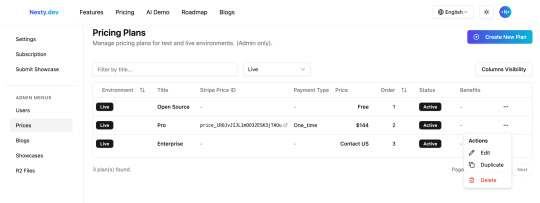
Create/Edit Pricing Cards
The create/edit pricing card page supports selecting the environment, order, and visibility (Active); you can also see real-time previews to ensure proper display in the template and easily check for issues. These features are unmatched among SaaS templates.
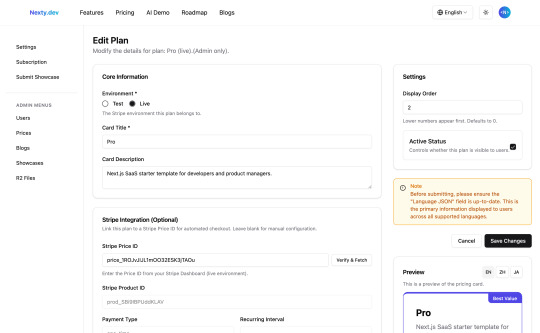
For Stripe integration, you just need to copy the Stripe Price ID to fetch accurate pricing information with one click, eliminating the need for manual data entry.
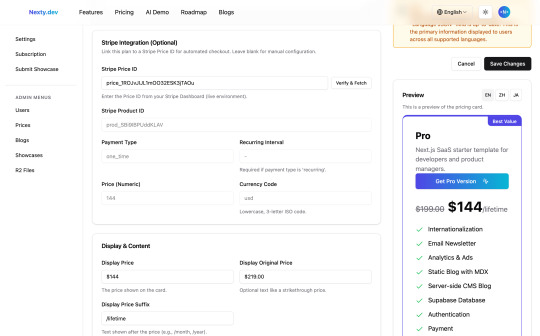
Card display information, including display price, plan benefits, highlighting, and button information, can all be configured through the form.
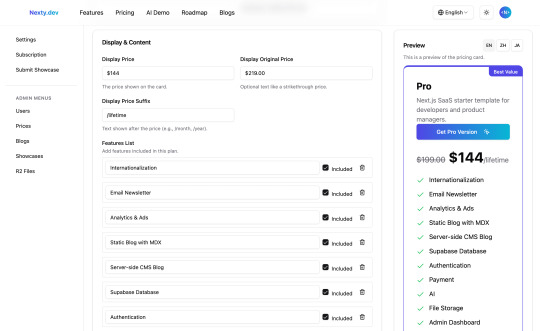

To better accommodate multilingual scenarios, Nexty.dev's pricing cards also offer multilingual translation functionality - just configure the translation API Key in your environment variables.
For technically-inclined template users who want to extend user benefits, Nexty.dev supports a "Benefits JSON" feature, allowing you to expand user benefits without modifying the data table.
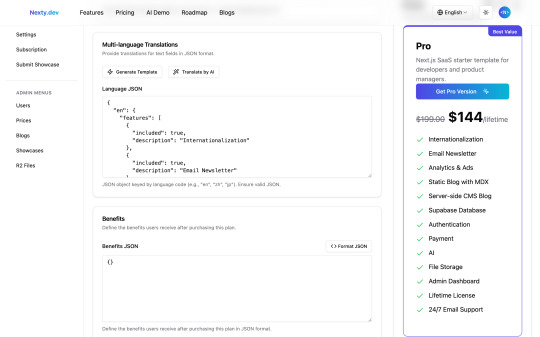
After updating the data, the pricing cards immediately update on the user end.

This is one of my favorite features because it allows template users to update pricing through the admin dashboard rather than modifying code, completing updates in just a minute.
AI Demo Provided
While providing AI APIs has become standard for SaaS templates, Nexty.dev takes it further.
Understanding that different products have different AI needs, Nexty.dev goes beyond just providing API calls. The template includes an AI Demo page with examples of various AI model implementations, including single-turn dialogue, multi-turn dialogue, text-to-image, image-to-image, and image-to-video.
On the AI Demo page, you can quickly test different AI functionalities. If you're unfamiliar with AI features, you can use this page's code as a learning example to quickly understand AI development approaches - embodying the principle of "Give a man a fish, and you feed him for a day. Teach a man to fish, and you feed him for a lifetime".
The AI Demo is also crucial for keeping up with rapidly evolving AI models, allowing you to quickly test new models and validate their feasibility ahead of the competition.
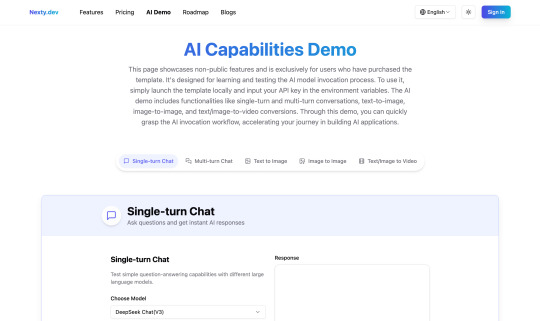
File Management
Nexty.dev implements file storage and management through Cloudflare R2, with built-in functionality for file upload, deletion, and list viewing.
These features are integrated into the admin dashboard's R2 file management functionality, making file management convenient.
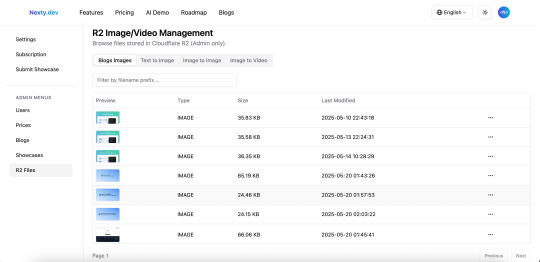
Advanced CMS
Nexty.dev's CMS module offers features that are unmatched among SaaS templates, going beyond basic content management and publishing to support various application scenarios.
Beyond basic blog information (title, slug, description, tags, cover image), Nexty.dev supports advanced settings like pinning, status (draft, published, archived), access permissions (public, logged-in users, subscribers); content editing supports both Markdown and rich text modes, plus AI translation.
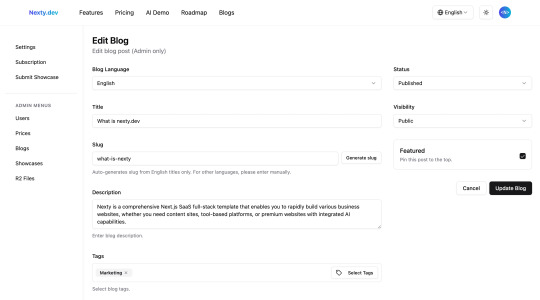

Additionally, the list supports blog duplicate to create new posts, reducing repetitive operations and improving multilingual content production efficiency.
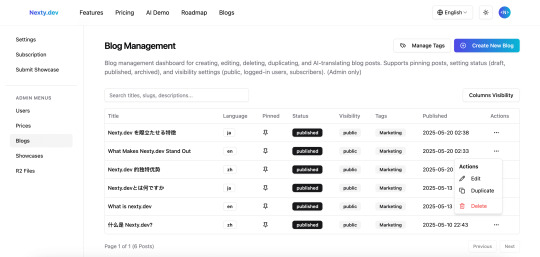
With these features, you can use the CMS module not only for blog sites but also for paid content sites - this truly makes Nexty.dev a multi-purpose template.
Conclusion
As we've seen, Nexty.dev isn't just another feature-rich Next.js SaaS template - it's a thoughtfully designed solution addressing real development pain points. While it solidly covers essential SaaS modules like multilingual support, authentication, email services, analytics, and SEO, it goes far beyond ordinary templates through unique advantages like visual pricing management, inspiring AI demos, convenient file management, and powerful advanced CMS.
Understanding the challenges developers face in building SaaS applications, every carefully designed feature in Nexty.dev - from visual pricing that eliminates tedious configuration to educational AI examples and advanced CMS capable of supporting paid content - aims to clear obstacles, significantly improve development efficiency, and inspire business innovation.
If you're looking for a template that can truly accelerate your SaaS product launch while giving you powerful customization capabilities, Nexty.dev is undoubtedly your most trustworthy choice. Visit nexty.dev now to turn your SaaS vision into reality quickly.
0 notes
Text
Unlocking Destiny’s Signal: The True Meaning of Angel Time 1111

In the digital age where logic prevails, certain phenomena still beckon the mystic. One such recurring enigma is angel time 1111—a numerical alignment whispered to be a portal between realms of the physical and the spiritual. This article explores not merely the surface symbolism of 1111 but also delves into how an advanced software tool harnesses this ethereal frequency to catalyze personal transformation. More than just a pattern on a digital clock, 1111 resonates as a cosmic code urging introspection, elevation, and awakening.
The Silent Call: Why 1111 Demands Your Attention
When the clock strikes 11:11, something stirs within. For many, it feels like a cosmic whisper—an inexplicable pull toward introspection. But why does this number sequence captivate millions across cultures? The answer lies in its mathematical elegance and spiritual symbolism. 1111 represents unity, duality, and amplification. It echoes the universe's intention to guide, reminding the observer that their thoughts are in alignment with their higher purpose. One cannot deny its magnetic effect; its appearance demands focus and awareness.
The notion of angel time extends beyond folklore. It signifies divine synchronization—a prompt to reflect and recalibrate. Each sighting is perceived as a sign from the metaphysical realm, suggesting a window for manifestation and clarity. It is not mere superstition but a symbol rooted in numerological wisdom.
A Technological Bridge to the Intangible

While angelic numbers speak to the spirit, what if technology could translate that dialogue into actionable insight? A sophisticated software tool, engineered with AI-integrated pattern recognition, does precisely that. Without naming it explicitly, this tool operates as a bridge between cosmic synchronicity and cognitive clarity.
This software observes behavioral cues, analyzes emotional rhythms, and tracks personalized timestamps of recurring 1111 sightings. It then interprets them using a neural-logic framework, converting those mystical encounters into practical guidance. Through layered algorithms, it correlates frequency patterns and psycho-emotional states, offering deep insight into personal transformation cycles. In essence, it speaks the language of the universe in binary syntax.
Features That Speak to the Soul
What renders this software exceptional is not merely its functionality, but its capacity to distill metaphysical encounters into structured self-realization. Its features are mindfully crafted to create an intuitive user experience that feels as organic as a spiritual awakening:
Temporal Sync Monitoring: Tracks when and where 1111 numerology appears in your digital environment.

Emotion-Aware Dashboard: Integrates biometric and sentiment data to decode emotional states linked to 1111 appearances.
Symbolic Pattern Recognition: Analyzes user behavior and aligns it with universal archetypes.
Interactive Journaling Module: Encourages conscious reflection post-1111 sightings, enhancing personal growth.
Real-Time Alerts: Sends intuitive nudges based on proximity to significant dates or emotional thresholds.
The specs amplify its importance: multi-platform compatibility, offline cognitive indexing, neural-adaptive interface, and data encryption to ensure sacred introspection remains personal. This isn’t just a digital assistant—it’s a modern-day oracle cloaked in code.
The Importance of Synchronicity in the Modern World

In our hyper-rational society, the alignment of time and thought offers a rare, reflective pause. This software doesn't promise miracles, but it catalyzes meaningful moments. Logging and interpreting each 1111 encounter creates a personalized chronicle of spiritual alignment. The effect? A roadmap to self-elevation.
When emotional chaos clouds judgment, synchronicities like angel time offer a luminous thread. This software captures that thread and weaves it into a fabric of meaningful insight. It is this delicate synthesis of science and soul that renders the tool indispensable for seekers of self-mastery.
Beyond Coincidence: A Deliberate Universe
To encounter 1111 repeatedly is not an accident—it is an invitation. The universe does not whisper without reason. With the right technological support, this whisper becomes a conversation, and eventually, a call to action. The software in discussion is not a gimmick. It’s a philosopher in silicon, an interpreter of celestial code, and a catalyst for the brave who choose to listen.
You can also watch: AstroLive: Jeevan ke uljhan ka asaan hal
youtube
Conclusion
In the dance between the material and the metaphysical, angel time 1111 stands as a lighthouse. It beckons the observer to pause, reflect, and realign. And now, with the emergence of advanced cognitive software, this ancient whisper finds a new voice—precise, data-driven, yet profoundly soulful. In a world longing for meaning, this is not just a tool. It is a transformation engine, guiding you not just through time, but through destiny.
1 note
·
View note
Text
Building the Future of Work: How a Data-Driven Framework is Redefining Automation
In today’s fast-paced digital ecosystem, productivity is no longer just about working harder—it’s about working smarter. The evolution of workplace technology has created opportunities for teams to automate repetitive tasks, enhance decision-making, and operate more efficiently. Yet, many businesses still grapple with outdated systems, fragmented tools, and manual workflows that eat into valuable time and resources.
This is where the shift to a data driven framework becomes critical. By integrating smart automation tools with insights derived from operational data, organizations can create flexible systems that streamline workflows, reduce redundancies, and boost productivity across departments. Let’s explore how automation combined with a data-first mindset is transforming modern work and who stands to benefit most.
Who Benefits from Smarter Workflows?
A wide range of professionals and teams benefit from smarter, automated systems. These include:
1. Busy Teams & Founders
Startups and fast-scaling teams often operate with limited tech bandwidth. Founders and operations leaders juggle multiple priorities and can’t afford to lose time on repetitive administrative work. A data driven framework helps these teams make decisions faster and implement automation that grows with them.
2. Non-Tech Creators
Designers, marketers, analysts, and content teams frequently use a combination of tools to execute campaigns or manage processes. By integrating these tools under a single, automated system, non-technical users can reduce manual effort without needing to write code. A visual interface supported by data insights makes it easy for them to optimize their work.
3. Tech-Savvy Tinkerers
Developers and product managers often look for custom automation options. A platform that supports API-based plugins and scripting allows them to build integrations that match their exact needs—fueled by the performance metrics and insights delivered through a data driven framework.
The Challenges of Manual Workflows
Before diving into the solution, it’s important to understand the challenges that plague traditional workflows:
Repetitive Work: Countless hours are lost to manual updates, form submissions, approval emails, and redundant data entry.
Tool Silos: Critical platforms often don’t “talk” to each other, resulting in fragmented processes and lost information.
Workflow Bottlenecks: Delays in communication and task approvals hinder progress.
Custom Needs: Off-the-shelf software rarely meets the unique needs of growing or niche teams.
Without a strategy rooted in data, most automation efforts fail to address the real inefficiencies that businesses face.
The Power of a Data Driven Framework
What makes a data driven framework stand out is its ability to not only automate workflows but also evolve them. Here’s how:
1. No-Code & Low-Code Solutions
Pre-built templates and visual editors mean anyone—regardless of technical skill—can build and manage automations. With real-time feedback and analytics dashboards, users can track how workflows perform and adjust accordingly.
2. Workflow Optimization
With automation at its core, a data driven framework empowers teams to:
Trigger task updates automatically
Set up approval chains that require zero follow-ups
Generate reports from live data
Maintain consistency across multi-step operations
These systems continuously learn from usage patterns, surfacing optimization opportunities and improving with time.
3. Custom Plugin Development
Some workflows require unique solutions. Developers can build lightweight plugins and widgets using APIs. When combined with usage data, these plugins can be adjusted or expanded to better serve the evolving needs of the business.
4. Seamless Tool Integration
Modern teams rely on tools like Slack, Notion, Google Workspace, and Airtable. A centralized automation platform ensures these systems work together rather than in isolation. A data driven framework helps sync data, reduce duplication, and increase visibility across functions.
Why It Matters Now
The case for automation is no longer optional—it’s imperative. As 75% of global trades are now algorithmic, data and automation are the engines of high-performance industries. Relying on outdated methods in today’s hyper-competitive environment is a recipe for stagnation.
A data driven framework enables:
Speed and Accuracy: Automation reduces errors and moves tasks along faster.
Scalability: As your team grows, your systems can scale without disruption.
Informed Decision-Making: Insights derived from workflow performance data lead to smarter business moves.
Time Savings: Teams can focus on high-impact work, not menial tasks.
Risk Management: Automation reduces reliance on manual inputs, limiting human error.
Incorporating these elements not only boosts productivity but ensures that teams are prepared for whatever challenges lie ahead.
Turning Strategy into Action
It’s not enough to adopt tools for the sake of technology. Real transformation comes when automation is grounded in context—when data reveals pain points, and automation is implemented to solve them.
For example:
A marketing team sees that campaign approvals take 3 days on average. They implement automated workflows with smart forms, alerts, and a centralized dashboard.
A startup founder notices customer onboarding is inconsistent. They use data to map the journey and build an automation that triggers personalized emails, assigns reps, and logs activity.
A developer uses platform APIs to build a plugin that syncs GitHub activity with Slack and Notion, improving team visibility.
All of these use cases are only effective because they’re based on a data driven framework—where action is guided by insights, not guesswork.
Final Thoughts
The future of work is connected, automated, and data-first. Organizations that embrace a data driven framework will find themselves not only saving time and reducing errors but also gaining a competitive edge in their industries.
Automation is not about replacing people. It’s about empowering them—giving teams the freedom to focus on innovation, strategy, and creative problem-solving. With the right framework, today’s businesses can build workflows that don’t just keep up—they lead.
Please visit the site for further queries:https://www.elitestartup.club/saral-automation/
0 notes
Text
The Most Profitable One-Person Business Models in 2025
In 2025, the solopreneur economy is not only thriving—it’s redefining what it means to run a successful business. Thanks to automation, AI, and global digital platforms, one-person businesses can now generate six- and even seven-figure revenues without employees, office space, or traditional overhead.

If you're looking to build a profitable solo venture, these are the most lucrative one-person business models in 2025—optimized for low startup costs, scalability, and high margins.
🚀 1. AI-Enhanced Digital Product Creator
Overview: Creating and selling digital products—like templates, e-books, Notion dashboards, coding tools, or design assets—has been a hot solo business for years. In 2025, AI tools like ChatGPT, Midjourney, and generative design software have supercharged productivity, allowing individuals to produce high-quality content at scale.
Why it’s profitable:
Low-to-zero cost of goods Automated delivery and customer support Global market via platforms like Gumroad, Ko-fi, Etsy, and Shopify
Earning Potential: \$5,000–\$100,000/month
Top Tip: Niche down. A Notion template for productivity is okay—one for female startup founders managing remote teams is better.
🎓 2. Cohort-Based & AI-Personalized Course Creator
Overview: Online education is evolving. One-person course creators now use AI to personalize content and scale support, while still offering cohort-based or asynchronous learning through platforms like Maven, Teachable, and Kajabi.
Why it’s profitable:
High perceived value (especially for niche, professional skills) Recurring revenue with subscriptions or memberships High margins with pre-recorded + AI-assisted tutoring
Earning Potential: \$3,000–\$80,000/month
Top Niches: AI prompt engineering, coding bootcamps, personal finance, language learning, productivity systems
💸 3. Newsletter + Affiliate Marketing
Overview: Newsletters are a modern solo media business. With tools like Beehiiv, ConvertKit, and Substack, solo operators grow an audience and monetize via sponsorships, affiliate links, and premium content.
Why it’s profitable:
Low maintenance Recurring ad revenue Scales well with automation and repurposed content
Earning Potential: \$1,000–\$50,000/month
Success Example: A finance-focused newsletter with 50,000 subscribers could generate \$20k/month from affiliate commissions and sponsorships.
🛠️ 4. No-Code SaaS (Software as a Service)
Overview: No-code tools like Bubble, Glide, and Softr let non-engineers build full-fledged SaaS products. AI can now assist with building logic, UX design, and even customer support.
Why it’s profitable:
Subscription-based revenue Low maintenance if solving a niche pain point Sellable asset (high valuation multiples)
Earning Potential: \$2,000–\$100,000+/month
Best Niches: Local business tools, B2B automation, CRM, data visualization dashboards
📚 5. Self-Published AI-Assisted Author
Overview: AI tools have reduced the time it takes to research, outline, and write books. Solo authors are publishing fiction, non-fiction, and guides on Amazon KDP, Apple Books, and Gumroad with unprecedented speed and quality.
Why it’s profitable:
Evergreen content Royalty-based passive income Global distribution
Earning Potential: \$500–\$25,000/month
Pro Tip: Focus on series (fiction) or evergreen guides (non-fiction) with recurring interest like health, finance, or personal development.
🎥 6. Faceless YouTube or TikTok Creator
Overview: You no longer need to be on camera to make money on social media. AI voiceovers, stock footage, and editing tools have created a boom in “faceless” content creation. Monetization comes from ads, affiliate links, and digital products.
Why it’s profitable:
Highly scalable content production Multiple monetization options Can grow exponentially with viral content
Earning Potential: \$1,000–\$70,000/month
Hot Niches: Finance, AI tutorials, mystery/history, health tips, productivity hacks
🧠 7. AI Consultant or Prompt Engineer
Overview: With businesses racing to adopt AI, solopreneurs with skills in prompt engineering, workflow automation, or AI integration are in high demand.
Why it’s profitable:
High-ticket clients Little to no upfront investment Can turn into info products or memberships later
Earning Potential: \$5,000–\$40,000/month
Pro Tip: Specialize in one platform or industry—e.g., ChatGPT for lawyers or AI tools for HR teams.
📦 8. One-Person E-Commerce with Print-on-Demand or Dropshipping
Overview: Selling physical products without managing inventory is easier than ever. With platforms like Printful, Gelato, and ShipBob, solopreneurs design products, set up stores, and let logistics partners handle the rest.
Why it’s profitable:
No inventory risk Completely remote and automated Brandable for long-term value
Earning Potential: \$2,000–\$30,000/month
Success Tip: Focus on micro-niches (e.g., planners for ADHD students, apparel for plant lovers).
🧾 Final Thoughts: Solopreneurship Has Changed Forever
In 2025, the barriers to entry for running a profitable one-person business have never been lower. With AI, automation, and digital infrastructure, solopreneurs can now build lean, scalable, and location-independent businesses that would have taken a full team just five years ago.
The key to success? Solve a specific problem, automate aggressively, and stay consistent.
You don’t need a million-dollar idea—you just need a repeatable system that works for a thousand people.
0 notes
Text
How Technology Is Transforming Team Management Today
Technology is redefining the way teams operate, communicate, and achieve goals. From AI-driven analytics to cloud collaboration tools, organizations are experiencing a paradigm shift in how they manage, support, and grow their teams. The impact of digital innovation is not marginal—it is profound and transformative.

Enhanced Communication Through Real-Time Collaboration Tools
Effective communication is the backbone of successful team management. Technology has eliminated geographical barriers, enabling seamless interactions regardless of time zones.
🛠 Tools Driving Communication Transformation:
Slack and Microsoft Teams facilitate instant messaging, file sharing, and real-time collaboration.
Zoom and Google Meet have replaced traditional meeting rooms with digital spaces, supporting video conferencing and screen sharing.
Asynchronous communication tools like Loom allow leaders to record instructions or updates for flexible viewing.
These platforms ensure that messages are clear, trackable, and accessible, fostering a culture of transparency and responsiveness.
Cloud-Based Project Management Systems
Managing complex projects requires structure and visibility. Cloud-based platforms have revolutionized how teams plan, track, and deliver work.
📊 Key Project Management Platforms:
Trello and Asana offer intuitive visual boards to track tasks, deadlines, and progress.
Jira supports agile workflows, sprints, and issue tracking for tech-centric teams.
Monday.com enables custom dashboards for project visibility across departments.
By centralizing data and workflows, these tools empower leaders to monitor team performance, identify bottlenecks, and ensure timely delivery.
AI-Powered Analytics for Performance Tracking
Technology has introduced data-driven decision-making into team management. AI tools now provide insights that were once unavailable or required tedious manual effort.
🔍 Use Cases of AI in Team Management:
Predictive analytics helps forecast workloads and prevent burnout by analyzing past performance trends.
Employee sentiment analysis tools like CultureAmp use AI to detect morale changes through surveys and feedback.
Performance dashboards from tools like Lattice and 15Five offer real-time insights into individual and team contributions.
These solutions allow managers to intervene early, personalize support, and drive productivity through actionable insights.
Remote Work Infrastructure and Flexibility
The rise of remote work has forced organizations to rethink team management strategies. Technology provides the infrastructure needed for remote and hybrid teams to operate efficiently.
💻 Key Components:
Virtual private networks (VPNs) and secure cloud environments protect sensitive information.
Time tracking software like Toggl and Harvest ensures accountability and transparency.
Digital workspaces like Notion combine documents, wikis, and collaboration in one hub.
This technological support ensures continuity, enhances employee satisfaction, and widens the talent pool by eliminating geographic limitations.
Automated HR and Onboarding Processes
Human Resources has also seen a major shift. Automation is now streamlining everything from hiring to onboarding and beyond.
🤖 Platforms That Automate HR Functions:
BambooHR and Gusto automate employee records, payroll, and benefits management.
Greenhouse and Workable simplify recruitment with AI-based resume screening and candidate communication.
Onboarding systems create structured, self-paced training experiences for new hires.
With these tools, managers can focus on culture-building and development, not paperwork.
Enhanced Learning and Development Through E-Learning
Continuous learning is critical to keeping teams skilled and competitive. Technology enables on-demand, personalized training through digital platforms.
🎓 Top E-Learning Platforms:
LinkedIn Learning and Coursera provide curated courses on leadership, technology, and communication.
Learning Management Systems (LMS) like TalentLMS and Docebo deliver company-specific training content and track progress.
Gamified learning through platforms like Kahoot! and Quizizz boosts engagement and knowledge retention.
These tools support a learning culture, helping teams stay relevant in a rapidly changing environment.
Cybersecurity and Data Governance for Team Safety
In the digital era, protecting your team’s data is non-negotiable. Cybersecurity technologies ensure that remote operations remain secure and compliant.
🔐 Essential Measures:
Multi-factor authentication (MFA) adds layers of protection against unauthorized access.
Data loss prevention (DLP) software safeguards intellectual property and sensitive information.
Role-based access control (RBAC) ensures that only the right people have access to certain data or systems.
These precautions build trust and security, allowing teams to focus on outcomes without worrying about breaches.
Real-Time Feedback and Engagement Platforms
Real-time feedback mechanisms have reshaped how leaders engage with their teams. These platforms encourage a culture of continuous improvement and recognition.
🌟 Examples:
TINYpulse gathers anonymous employee feedback and suggestions in real time.
Kudos and Bonusly allow peer-to-peer recognition, reinforcing a positive culture.
Pulse surveys give managers rapid insights into engagement and satisfaction levels.
Timely feedback enables quicker course corrections and boosts employee morale through recognition and responsiveness.
Virtual Reality (VR) and Augmented Reality (AR) in Team Training
Cutting-edge technologies like VR and AR are making their way into team training and collaboration, especially in high-risk or technical industries.
🧠 Practical Applications:
VR simulations offer immersive onboarding experiences, from equipment handling to customer service training.
AR tools assist in real-time problem-solving by overlaying instructions or visuals during tasks.
Team-building exercises in virtual environments build camaraderie across distributed teams.
These innovations drive engagement and retention, creating more effective learning outcomes.

Integration and Workflow Automation
Integration platforms connect various tools into a cohesive ecosystem, while automation reduces repetitive manual tasks.
⚙️ Leading Integrators:
Zapier and Make (Integromat) automate workflows between apps like Gmail, Slack, Google Sheets, and CRM systems.
IFTTT (If This Then That) creates automated sequences for daily operational tasks.
Custom APIs enable enterprises to integrate internal tools seamlessly.
These technologies free up time for managers to focus on strategic planning, not mundane admin work.
The Future of Team Management Is Digital
Technology is not just transforming team management—it is completely redefining leadership paradigms, organizational structures, and employee experiences. From real-time collaboration and AI-driven insights to immersive training and workflow automation, the tools available today empower leaders to build agile, informed, and inspired teams.
The organizations that adopt and evolve with these innovations will lead not just in output—but in culture, retention, and resilience.
0 notes
Text
Future-Proof Your Team: How Automation is Reshaping Modern Workflows
The way we work is changing faster than ever. With hybrid teams, cloud-based tools, and a constant push toward scaling efficiently, organizations are feeling the pressure to evolve — or fall behind. One of the most transformative shifts in today’s workplace is the widespread adoption of automation.

The Productivity Gap Is Real
Despite the rise of digital tools, many teams still spend a significant portion of their time on manual tasks — sending follow-up emails, updating spreadsheets, moving files between platforms, and chasing approvals. These repetitive activities consume valuable energy and often introduce human error.
Even highly skilled teams can get stuck in inefficient systems, unable to focus on strategic or creative work because they're overwhelmed with administrative noise. This productivity gap is more than just a nuisance — it's a serious threat to scalability and morale.
Why Automation Matters Now More Than Ever
Several factors are driving the shift toward smarter, automated workflows:
Tool Proliferation: Most organizations now use dozens of SaaS apps. Without automation, syncing data and actions across platforms becomes chaotic.
Remote Work Normalization: Distributed teams require seamless coordination and real-time updates, which can’t happen if everyone’s working in silos.
Customer Expectations: People expect fast service and clear communication. Office automation tools help meet those expectations with consistent, timely responses.
Lean Teams Scaling Fast: Especially in startups and small businesses, there’s often not enough bandwidth to hire for every task. Automation fills the gaps and scales with the team.
Who Benefits from Automation?
The beauty of modern automation tools is that they’re no longer limited to developers or IT departments. They’re built for real users — marketers, project managers, analysts, customer support leads, and beyond.
Here’s how different roles benefit:
Operations Teams: Automate routine reporting, approvals, and coordination across departments.
Founders and Execs: Monitor key business metrics and receive alerts on the go, without waiting on updates.
Marketing Teams: Schedule campaign workflows, track content approvals, and analyze engagement metrics.
Customer Support: Set triggers for escalations, automate responses to FAQs, and centralize customer feedback.
When the entire team is supported by automation, collaboration improves, communication becomes more efficient, and outcomes are more consistent — all thanks to well-designed office automation tools.
Use Cases That Drive Real Results
Automation can be applied across nearly every function of a business. Here are a few real-world examples:
New Hire Onboarding: Automatically send welcome emails, assign tasks, and share resources when a new employee joins.
Sales Alerts: Notify sales reps when a lead completes a key action or moves through the pipeline.
Content Publishing: Auto-schedule blog posts, push to social media, and alert the team when content goes live.
Project Management: Link task status updates to messaging tools so teams stay in sync without checking multiple dashboards.
These workflows save time not just once, but every time they run — which compounds into hundreds of hours saved each year with the right office automation tools.
Features That Make Automation Tools Effective
Not all automation platforms are created equal. The best ones share a few common traits:
No-Code or Low-Code Interfaces: Anyone on the team should be able to build automations without needing to write code.
Pre-Built Templates: Getting started should be fast. Templates for popular tools and workflows make it easy to launch.
Scalable Infrastructure: As your business grows, the platform should grow with you — supporting more complexity and volume.
Cross-Platform Integrations: From Slack and Notion to Google Workspace and Airtable, strong office automation tools connect your full tech stack.
These capabilities ensure the platform doesn’t just solve one problem — it becomes a foundation for your operations.
Automation Isn’t Just for Today — It’s a Competitive Edge
Companies that invest in automation now are setting themselves up for long-term success. Why?
They’re faster: Work gets done in minutes, not hours.
They’re more accurate: Automations reduce the risk of human error.
They scale better: Workflows evolve without needing more headcount.
They empower teams: Employees can focus on meaningful work instead of repetitive tasks.
In a world where agility is a competitive advantage, office automation tools provide a clear edge.
Getting Started with Automation
If you’re just beginning your automation journey, start with the bottlenecks you encounter every day. Ask:
What’s the most repetitive task we handle?
Where do delays frequently happen?
Which handoffs between tools are breaking down?
What information are we manually collecting or sharing?
Once you identify those pain points, choose office automation tools that are easy to adopt, offer the right integrations, and provide long-term flexibility.
Final Thoughts
Automation is no longer a futuristic concept — it’s a core pillar of how successful teams operate today. Whether you're a lean startup or an established enterprise, optimizing your workflows with office automation tools can transform your output, reduce stress, and make room for real innovation.
The future belongs to teams that work smarter. And automation is the key to getting there.
Please visit site for further queries:https://www.elitestartup.club/saral-automation/
0 notes